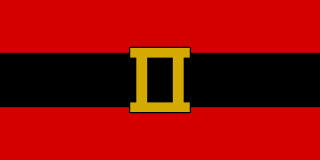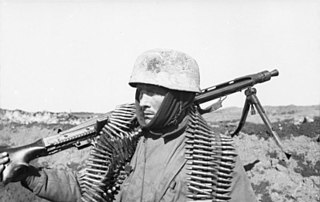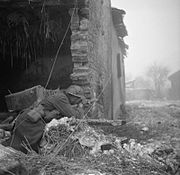
Roermond is a city, municipality, and diocese in the Limburg province of the Netherlands. Roermond is a historically important town on the lower Roer on the east bank of the river Meuse. It received town rights in 1231. Roermond's town centre has become a designated conservation area.

The 7th Armoured Division was an armoured division of the British Army. It was formed as the Mobile Division (Egypt) on 27 September 1938, after increased tensions between Britain and the Axis powers. This was part of an effort to reinforce and maintain the British strategic presence in Egypt to defend the Suez Canal, which was seen as vital to the British Empire's interests. In February 1940, the formation was renamed as the 7th Armoured Division. During its early years, the Jerboa was adopted as the mascot and divisional insignia giving rise to the nickname Desert Rats.

The 21st Army Group was a British headquarters formation formed during the Second World War. It controlled two field armies and other supporting units, consisting primarily of the British Second Army and the First Canadian Army. Established in London during July 1943, under the command of Supreme Headquarters Allied Expeditionary Force (SHAEF), it was assigned to Operation Overlord, the Western Allied invasion of Europe, and was an important Allied force in the European Theatre. At various times during its existence, the 21st Army Group had additional British, Canadian, American and Polish field armies or corps attached to it. The 21st Army Group operated in Northern France, Luxembourg, Belgium, the Netherlands and Germany from June 1944 until August 1945, when it was renamed the British Army of the Rhine (BAOR).

The 52nd (Lowland) Infantry Division was an infantry division of the British Army that was originally formed as the Lowland Division, in 1908 as part of the Territorial Force. It later became the 52nd (Lowland) Division in 1915. The 52nd (Lowland) Division fought in the First World War before being disbanded, with the rest of the Territorial Force, in 1920.

The British Second Army was a field army active during the First and Second World Wars. During the First World War the army was active on the Western Front throughout most of the war and later active in Italy. During the Second World War the army was the main British contribution to the Normandy landings on 6 June 1944 and advance across Europe.

The Rur or Roer is a major river that flows through portions of Belgium, Germany and the Netherlands. It is a right (eastern) tributary to the Meuse. About 90 percent of the river's course is in Germany.

Operation Veritable was the northern part of an Allied pincer movement that took place between 8 February and 11 March 1945 during the final stages of the Second World War. The operation was conducted by Field Marshal Bernard Montgomery's Anglo-Canadian 21st Army Group, primarily consisting of the First Canadian Army under Lieutenant-General Harry Crerar and the British XXX Corps under Lieutenant-general Brian Horrocks.

The 8th Armoured Brigade was an armoured brigade of the British Army formed in August 1941, during the Second World War and active until 1956. The brigade was formed by the renaming of 6th Cavalry Brigade, when the 1st Cavalry Division based in Palestine converted from a motorised formation to an armoured unit, becoming 10th Armoured Division.

Fallschirmjäger Regiment Hübner was formed as a reserve unit in August 1944, attached to 7th Parachute Division in September 1944, and operated as an independent Battle Group from November 1944 until March 1945, when it was formally designated Fallschirmjäger Regiment (FJR) 24 and subordinated to the 8th Parachute Division.

Operation Queen was an American operation during World War II on the Western Front at the German Siegfried Line.

The Fallschirmjäger were the paratrooper branch of the German Luftwaffe before and during World War II. They were the first paratroopers to be committed in large-scale airborne operations. Throughout World War II, the commander of the branch was Kurt Student.
The 156th Brigade was an infantry brigade formation of the British Army. The brigade saw active service in both the First and the Second World Wars with the 52nd (Lowland) Infantry Division.
The 155th Brigade was an infantry brigade of the British Army that saw active service in both the First and the Second World Wars. Assigned to the 52nd (Lowland) Division, the brigade saw active service in the Middle East and on the Western Front during the First World War. During the Second World War, now the 155th Infantry Brigade, it continued to serve with the 52nd Division in Operation Dynamo, and later in North-western Europe from late 1944 until May 1945.
The 157th Brigade was an infantry brigade of the British Army. The brigade fought in both the First and the Second World Wars, assigned to 52nd (Lowland) Infantry Division.

79th (Lowland) Field Regiment was a Royal Artillery (RA) unit of Britain's part-time Territorial Army (TA) during World War II. It was descended from the 1st Ayrshire and Galloway Artillery Volunteers, first raised in Scotland in 1859. It served in Home Forces for most of the war, undergoing training in mountain warfare and air-portable operations before eventually going into action at sea level in the Battle of the Scheldt. It then took part in the fighting in the Rhineland, and then the drive to Bremen. It was reformed in the postwar TA, and continued until 1967.

The 108th Light Anti-Aircraft Regiment, Royal Artillery, was an air defence unit of the British Army during World War II. Initially raised as an infantry battalion of the Green Howards in 1940, it transferred to the Royal Artillery in 1942. It served with 52nd (Lowland) Infantry Division, training for mountain warfare and airlanding operations, but finally went into action at sea level in the Battle of the Scheldt in the autumn of 1944. It fought through the battles in the Rhineland and Germany in 1945 until the end of the war, after which it was disbanded.

80th Field Regiment was a Royal Artillery (RA) unit of Britain's part-time Territorial Army (TA) during World War II. It was descended from the 1st Lanarkshire Artillery Volunteers, first raised in Scotland in 1859. It served in Home Forces for most of the war, undergoing training in mountain warfare and air-portable operations before eventually going into action at sea level in the Battle of the Scheldt. It then took part in the fighting in the Rhineland, and then the drive to Bremen. It was reformed in the postwar TA, and continued until 1961.

186th Field Regiment was a unit of Britain's Royal Artillery (RA) during World War II. It was formed in Scotland and joined 52nd (Lowland) Infantry Division remaining with that formation for its whole existence. It served in Home Forces for most of the war, undergoing training in mountain warfare and air-portable operations before eventually going into action at sea level in the Battle of the Scheldt. It then took part in the fighting in the Rhineland, and then the drive to Bremen. It was disbanded at the end of the war.

The 9th Medium Regiment was a Royal Artillery unit, formed in the British Army during World War II. First raised in 1940 as infantry of the Buffs, it was converted to the medium artillery role in 1942 and fought in the campaign in North West Europe. It was disbanded after the war.

The 11th Medium Regiment was a Royal Artillery unit, formed in the British Army during World War II. First raised in 1940 as infantry of the Essex Regiment, it was converted to the medium artillery role in 1942 and fought in the campaign in North West Europe. It was disbanded after the war.














